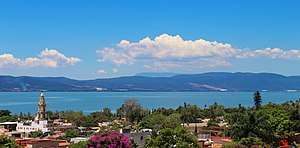Ajijic

Ajijic (Spanish pronunciation: [axiˈxik] (![]()
Geography
Ajijic is located (at 20°18"N, 103°15"W) 5,046 feet (1,538 m) above sea level in the vast central Mexican plateau that is home to the Sierra Madre mountain range.
The Chapala Lake basin has a year-round average temperature of about 72 °F (22 °C). Due to Ajijic's tropical latitude, the sun is warm year-round; due to its relatively high elevation, it is seldom unpleasantly hot or humid. The rainy season begins in June and lasts until October with an average rainfall of approximately 34 inches (860 mm) in total over those five months. Even during the rainy season, precipitation generally occurs during the evening or at night.
December and January are the coolest months and May is the hottest, just before the onset of the rainy season. Overall, there is very little temperature variation year round: daytime highs in January are around 75 °F (24 °C); daytime highs in May are around 80 °F (27 °C) to 90 °F (32 °C).
History

Up until the arrival of the Spanish, the region was occupied by nomadic Indian tribes, probably the Cocas tribe that settled the northern shore. There seem to be many explanations, and meanings for the names Chapala and Ajijic, all of which are Indian place names, probably derived from Nahuatl, the native language of the area.
Ajijic's population of 10,509 (2010 census) excludes the hundreds of visitors from Guadalajara (35 miles (56 km) north) who spend weekends and vacations there. Many retired Americans and Canadians now live in Ajijic, about 1,000 full-time and another 700 during the winter months. As a result of these foreign residents and visitors, Ajijic has numerous art galleries, fashion and curio shops, as well as restaurants and bed and breakfast inns. The Lake Chapala Society on the grounds of the former estate of Neill James in central Ajijic has about 3,000 mostly foreign members.[2] It serves as a focus of over 50 expat activities and services for the estimated 40,000 foreign residents[3] who live around Lake Chapala. Mexico's National Chili Cook-Off has been held in Ajijic since 1978 and currently attracts thousands of Mexican and International visitors each February.[4]
Popular culture
Ajijic has attracted foreign artists and writers since the 1890s.[5] Englishmen Nigel Millet and Peter Lilley settled in Ajijic before World War II and under the pen name of Dane Chandos wrote Village in the Sun (1945, G.P. Putnam's Sons), about building a house on the edge of the lake in nearby San Antonio Tlayacapan. Using the same pen name, Peter Lilley later teamed up with Anthony Stansfeld (an English academic) to write House in the Sun (1949), which concerns the operation of a small inn in Ajijic. They were written when the main road was unpaved, ice was delivered by bus from Guadalajara, and electricity was just being installed.[6]
References
- ↑ Chapala Tourist Site
- ↑ Lake Chapala Society
- ↑ https://www.telegraph.co.uk/expat/health/glorious-weather-and-cheap-living-mexicos-lakeside-retirement-ha/
- ↑
- ↑ Lake Chapala Through The Ages, an Anthology of Travelers' Tales (Sombrero Books, 2008)
- ↑ mexconnect.com
External links
| Wikivoyage has a travel guide for Ajijic. |
![]()